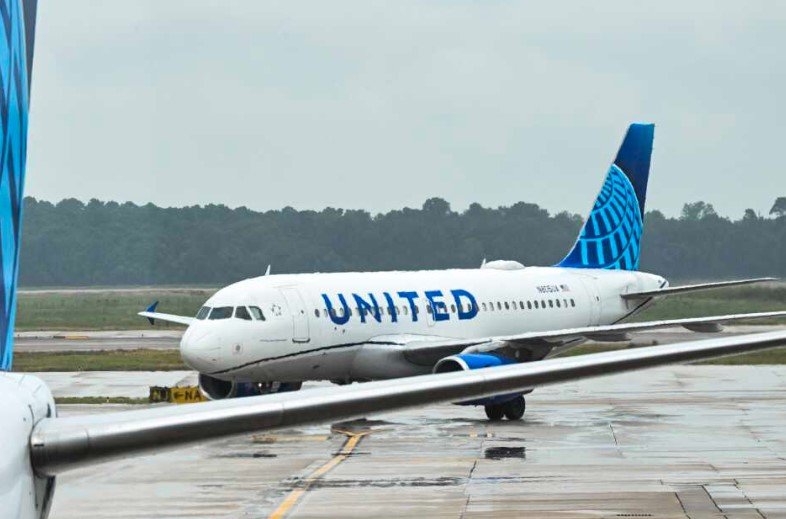CEO Scott Kirby briefs DOT as FAA lends support; 1,100 flights delayed, passengers left stranded into Thursday
A technology failure at United Airlines forced a nationwide ground stop Wednesday evening, throwing flight schedules into chaos, frustrating travelers across the country, and raising fresh concerns about airline IT reliability—just two weeks after a similar scare at Alaska Airlines.
The glitch was resolved within a few hours, but ripple effects were still being felt into Thursday morning, with more delays and cancelations piling up.
United Blames “Technology Issue,” Offers Few Details
United didn’t say much when the chaos started.
The carrier confirmed around 7:45 p.m. Eastern that it was holding all mainline departures due to a technology issue, but it didn’t clarify whether the problem was in its reservation system, flight dispatch software, or aircraft communication tools.
The Federal Aviation Administration (FAA), which monitors such disruptions, said it was made aware of the situation and “offered full support to help address their flight backlog.”
One FAA insider told a regional news outlet that the issue appeared isolated to United and “had no bearing on the wider air traffic control system.”
One sentence here.
That was echoed by Transportation Secretary Sean Duffy, who posted on X that United CEO Scott Kirby had personally briefed him on the situation.
Major Hubs Jammed as Ground Stops Trigger Backups
By the time United requested the first ground stop, major airports were already seeing backups.
The FAA confirmed that flights out of Chicago O’Hare, Newark Liberty, Denver International, Houston Bush Intercontinental, and San Francisco International were impacted.

Passengers stuck on tarmacs or stranded at gates shared photos of chaotic departure boards, while airline employees reportedly struggled to provide updates as backend systems slowed down or stopped syncing.
“I was supposed to fly from Newark to Seattle at 8 p.m.,” said Thomas Redley, a marketing exec trying to get to a conference. “At 9:30, they said we’re still waiting on clearance. Then at 10:15, it got canceled altogether. No explanation.”
According to FAA logs, here’s how the sequence unfolded:
-
6:12 p.m. ET – Issue reportedly begins, per United.
-
7:42 p.m. ET – First ground stop request sent.
-
9:00 p.m. ET – San Francisco lifts stop.
-
10:00 p.m. ET – United announces resolution.
One sentence paragraph.
But by then, the damage was done.
By The Numbers: Delay and Cancelation Fallout
Flight-tracking service FlightAware offered a grim tally of the mess left behind:
| Date/Time | United Flights Delayed | United Flights Canceled |
|---|---|---|
| Wed (Full Day) | 1,096 (35% of daily schedule) | 157 |
| Thurs (Early AM) | 79 | 70 |
Several of the Thursday cancelations involved repositioning aircraft that had been grounded or stranded overnight.
Passengers took to social media in droves, with #UnitedDown trending for several hours late Wednesday night.
One tweet read: “Not again. First Alaska, now United. Are airlines just running on spaghetti code?”
United to Cover Hotel Costs, Treats Delays as “Preventable”
In an unusual move, CBS News reported that United has classified delays linked to the tech issue as preventable—a distinction that obligates the airline to cover customer expenses such as hotel stays, meals, or rebookings.
That’s a break from the typical playbook. Airlines often cite weather or “uncontrollable” events to dodge reimbursement claims.
“We want to do right by our customers,” a spokesperson said in a late-night statement. “This issue was on us.”
• Some airports, including Houston and Newark, set up temporary help desks overnight to assist displaced travelers
• Affected passengers are being offered rebooking or full refunds without penalties
One customer service rep, working the overnight shift at Denver International, described the volume as “like a mini-pandemic flashback.”
Deja Vu: Another Tech Outage Just Weeks After Alaska Meltdown
The timing couldn’t be worse—or more ironic.
Just two weeks ago, Alaska Airlines grounded its entire fleet for several hours due to what it described as an IT systems failure. That outage also halted flights at its subsidiary Horizon Air, sparking similar delays, stranded passengers, and a mountain of customer complaints.
At the time, Alaska said it was investigating vulnerabilities in its dispatch network. No cyberattack was reported in that case.
Industry analysts say these back-to-back incidents raise deeper questions.
“This is a resilience problem,” said travel technology expert Anita Moore. “You’ve got highly complex legacy systems patched together with modern tools. Something always breaks—and when it does, the impact is nationwide.”
Airlines’ Fragile IT Systems: A Chronic Problem?
United, like most U.S. carriers, runs on a mix of old and new technologies. Reservation systems, crew scheduling, weather radar integration, aircraft dispatch—it’s a delicate balance of digital and mechanical.
One former airline IT manager said most major U.S. carriers still rely on software stacks that haven’t seen a full rebuild in over 20 years.
“It’s like flying a brand-new 787 while using Windows 98 behind the scenes,” he quipped.
• In 2023, a FAA NOTAM system failure grounded all flights nationwide for hours
• In 2021, Southwest faced a similar outage tied to its weather data feed
• Earlier this year, Delta experienced multiple reservation system crashes during peak holidays
For passengers, that means delays may not always come from storms or crew shortages—but from code.
What Comes Next?
With the issue resolved, United says it’s focusing on recovery mode, trying to reset schedules and accommodate displaced flyers.
Still, several key questions remain unanswered:
-
What exactly was the root cause of the technology failure?
-
Why did it take nearly four hours to resolve?
-
How will United prevent a recurrence—especially during peak holiday periods?
As of Thursday morning, operations were slowly returning to normal, but travelers remain wary.
“It’s not just about making it up to us,” said Redley, the delayed passenger from Newark. “It’s about making sure it doesn’t happen again next week.”








